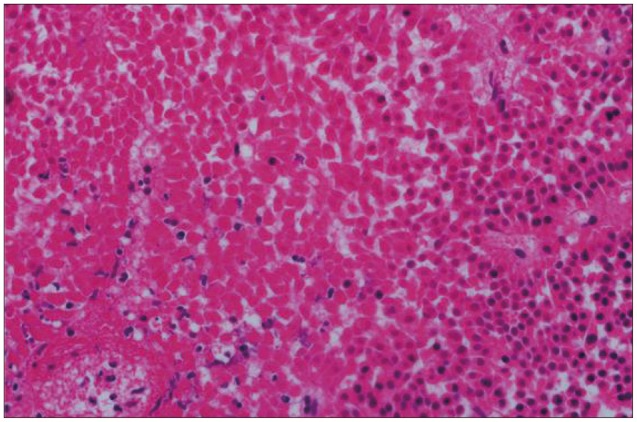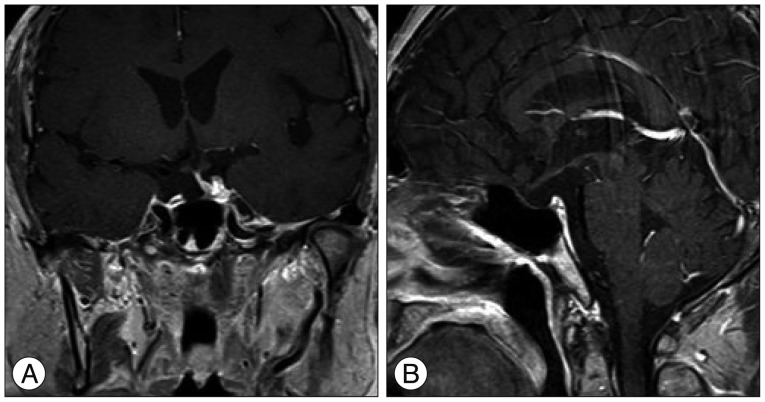J Korean Neurosurg Soc.
2015 Apr;57(4):289-291. 10.3340/jkns.2015.57.4.289.
Pituitary Apoplexy Following Mitral Valvuloplasty
- Affiliations
-
- 1Department of Neurosurgery, School of Medicine, Pusan National University, Yangsan, Korea. sangweonlee@pusan.ac.kr
- KMID: 1956428
- DOI: http://doi.org/10.3340/jkns.2015.57.4.289
Abstract
- Pituitary apoplexy is a rare but potentially life-threatening clinical syndrome caused by the sudden enlargement of a pituitary adenoma secondary to hemorrhage or infarction. Pituitary apoplexy after cardiac surgery is a very rare perioperative complication. Factors associated with open heart surgery that may lead to pituitary apoplexy include hemodynamic instability during cardiopulmonary bypass and systemic heparinization. We report a case of pituitary apoplexy after mitral valvuloplasty with cardiopulmonary bypass. After early pituitary tumor resection and hormonal replacement therapy, the patient made a full recovery.
MeSH Terms
Figure
Reference
-
1. Bailey P. Pathological report of a case of acromegaly, with special reference to the lesions in the hypophysis cerebri and in the thyroid gland; and a case of haemorrhage in to the pituitary. Philadelphia Med J. 1898; 1:789–792.2. Bills DC, Meyer FB, Laws ER Jr, Davis DH, Ebersold MJ, Scheithauer BW, et al. A retrospective analysis of pituitary apoplexy. Neurosurgery. 1993; 33:602–608. discussion 608-609. PMID: 8232799.
Article3. Biousse V, Newman NJ, Oyesiku NM. Precipitating factors in pituitary apoplexy. J Neurol Neurosurg Psychiatry. 2001; 71:542–545. PMID: 11561045.
Article4. Bleibtreu L. Ein Fall von Akromegalie (Zerstorung der Hypophysis durch Blutung). Munch Med Wochenschr. 1905; 41:2079–2080.5. Brougham M, Heusner AP, Adams RD. Acute degenerative changes in adenomas of the pituitary body--with special reference to pituitary apoplexy. J Neurosurg. 1950; 7:421–439. PMID: 14774761.
Article6. Cardoso ER, Peterson EW. Pituitary apoplexy : a review. Neurosurgery. 1984; 14:363–373. PMID: 6369168.7. Cooper DM, Bazaral MG, Furlan AJ, Sevilla E, Ghattas MA, Sheeler LR, et al. Pituitary apoplexy : a complication of cardiac surgery. Ann Thorac Surg. 1986; 41:547–550. PMID: 3486645.8. De la Torre M, Alcázar R, Aguirre M, Ferreras I. The dialysis patient with headache and sudden hypotension : consider pituitary apoplexy. Nephrol Dial Transplant. 1998; 13:787–788. PMID: 9550672.
Article9. Goel A, Deogaonkar M, Desai K. Fatal postoperative 'pituitary apoplexy' : its cause and management. Br J Neurosurg. 1995; 9:37–40. PMID: 7786424.10. Levy E, Korach A, Merin G, Feinsod M, Glenville B. Pituitary apoplexy and CABG : should we change our strategy? Ann Thorac Surg. 2007; 84:1388–1390. PMID: 17889010.11. Mizuno T. Pituitary apoplexy with third cranial nerve palsy after off-pump coronary artery bypass grafting. Interact Cardiovasc Thorac Surg. 2011; 13:240–242. PMID: 21527463.
Article12. Mukhida K, Kolyvas G. Pituitary apoplexy following cardiac surgery. Can J Neurol Sci. 2007; 34:390–393. PMID: 17803046.
Article13. Nagarajan DV, Bird D, Papouchado M. Pituitary apoplexy following anticoagulation for acute coronary syndrome. Heart. 2003; 89:10. PMID: 12482780.
Article14. Nawar RN, AbdelMannan D, Selman WR, Arafah BM. Pituitary tumor apoplexy : a review. J Intensive Care Med. 2008; 23:75–90. PMID: 18372348.




